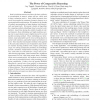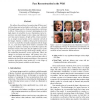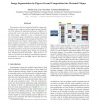ICCV
2011
IEEE
13 years 6 months ago
2011
IEEE
We address the problem of learning view-invariant 3D models of human motion from motion capture data, in order to recognize human actions from a monocular video sequence with arbi...
ICCV
2011
IEEE
13 years 6 months ago
2011
IEEE
We describe a directed bilinear model that learns higherorder groupings among features of natural images. The model represents images in terms of two sets of latent variables: one...
ICCV
2011
IEEE
13 years 6 months ago
2011
IEEE
We propose a visual recognition system that is designed for fine-grained visual categorization. The system is composed of a machine and a human user. The user, who is unable to c...
143
click to vote
ICCV
2011
IEEE
13 years 6 months ago
2011
IEEE
We present a hierarchical model that learns image decompositions via alternating layers of convolutional sparse coding and max pooling. When trained on natural images, the layers ...
ICCV
2011
IEEE
13 years 6 months ago
2011
IEEE
Rank correlation measures are known for their resilience to perturbations in numeric values and are widely used in many evaluation metrics. Such ordinal measures have rarely been ...
ICCV
2011
IEEE
13 years 6 months ago
2011
IEEE
We address the problem of reconstructing 3D face models from large unstructured photo collections, e.g., obtained by Google image search or from personal photo collections in iPho...
ICCV
2011
IEEE
13 years 6 months ago
2011
IEEE
We present an active geodesic contour model in which we constrain the evolving active contour to be a geodesic with respect to a weighted edge-based energy through its entire evol...
ICCV
2011
IEEE
13 years 6 months ago
2011
IEEE
Convex relaxation techniques have become a popular approach to image segmentation as they allow to compute solutions independent of initialization to a variety of image segmentati...
ICCV
2011
IEEE
13 years 6 months ago
2011
IEEE
We propose a mid-level statistical model for image segmentation that composes multiple figure-ground hypotheses (FG) obtained by applying constraints at different locations and s...
ICCV
2011
IEEE
13 years 6 months ago
2011
IEEE
The number of applications in computer vision that model higher-order interactions has exploded over the last few years. The standard technique for solving such problems is to red...



